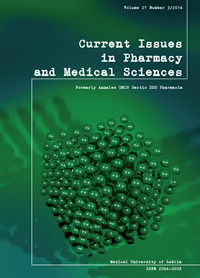Application of atomic absorption spectrometry with continuous light source to analyze selected metals important for human health in different parts of oranges
DOI:
https://doi.org/10.1515/cipms-2015-0003Keywords:
metal ions, elements, trace analysis, oranges, H-R CS AASAbstract
The publication describes the application of high-resolution continuum source atomic absorption spectrometry (H-R CS AAS) to determine some physiologically essential and toxic elements occurring in citrus fruits of different origins. Before analysis, the samples were mineralized using a mixture of deionized water and 69% nitric acid 3:1 (v/v) in high pressure microwave digestion at 188°C during one hour.
The obtained validation parameters for AAS such as high linearity (the correlation coefficient R > 0,997) and high precision expressed as relative standard deviation (%RSD) were satisfactory for quantification.
Cadmium at concentration range from 0.29 to 0.43 mg/kg was determined in all tested samples, however the obtained values did not exceed Polish standards. The higher concentration of potassium comparing to sodium and calcium was noted in each investigated samples. The highest variation was observed for calcium, its concentration strongly depended on the country of origin.
References
1. Chadwick L.R., Pauli G.F., Farnsworth N.R.: The pharmacognosy of Humulus lupulus L. (hops) with an emphasis on estrogenic properties. Phytomedicine, 13, 119, 2006.
2. Colgate E.C. et al.: Xanthohumol, a prenylflavonoid derived from hops induces apoptosis and inhibits NF-kappaB activation in prostate epithelial cells. Cancer Letters, 246, 201, 2007.
3. Gerhauser C.: Broad spectrum antiinfective potential of xanthohumol from hop (Humulus lupulus L.) in comparison with activities of other hop constituents and xanthohumol metabolites. Molecular Nutrition Food Research 49, 827, 2005.
4. Jabeen, K. et al. Antifungal compounds from Melia azederach leaves for management of Ascochyta rabiei, the cause of chickpea blight, Nat. Prod. Res., 25, 264, 2011.
5. Schiller H. et al.: Sedating effects of Humulus lupulus L. extracts. Phytomedicine 13, 535, 2006.
6. Trojak-Goluch A., Skomra U.: Artifically induced polyploidization in Humulus lupulus L. and its effect on morphological and chemical traits. Breeding Sci., 63, 393, 2013.
7. Van Cleemput M. et al.: Hop (Humulus lupulus)-derived bitter acids as multipotent bioactive compounds. J. Nat. Prod., 72, 1220, 2009.
8. Wang X. et al: In vitro and in vivo antioxidant and antimutagenic activities of polyphenols extracted from hops (Humulus lupulus L.). J Sci Food Agric., 94, 1693, 2014.
9. Wansi J. P. et al.: Antimicrobial and antioxidante effects of phenolic constituents from Klainedoxa gabonensis. Pharmaceutical Biology, 48, 1124, 2010.
10. Yu L. et al.: Novel prenylated bichalcone and chalcone from Humulus lupulus and their quinone reductase induction activities. Fitoterapia, 93, 115, 2014.
11. Zanoli, P. et al.: Evidence that the acids fraction of hops reduces central GABAergic neurotransmission. J. Ethnopharmacol., 109, 87, 2007.
12. Zanoli P., Zavatti M.: Pharmacognostic and pharmacological profile of Humulus lupulus L. J. Ethnopharmacol., 116, 383, 2008.
13. Zheng, Y. et al.: Antibacterial compounds from Siraitia grasvenorii leaves, Nat. Prod. Res., 25, 890, 2011.
Downloads
Published
Issue
Section
License
Copyright (c) 2015 Authors

This work is licensed under a Creative Commons Attribution-NonCommercial-NoDerivatives 3.0 Unported License.


